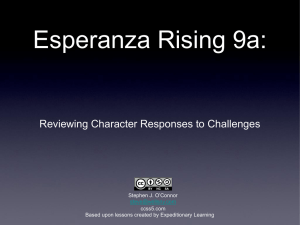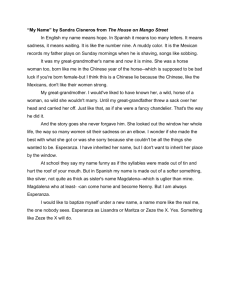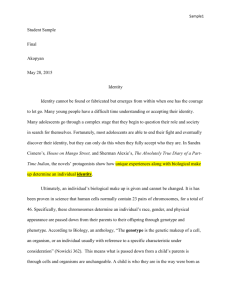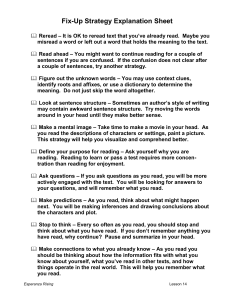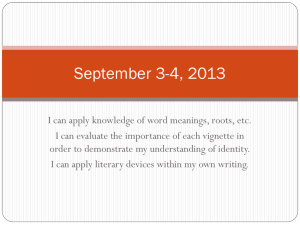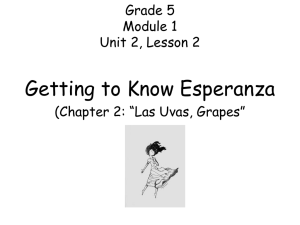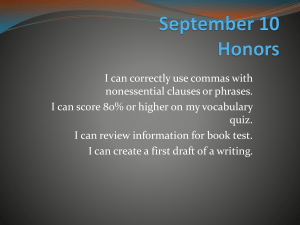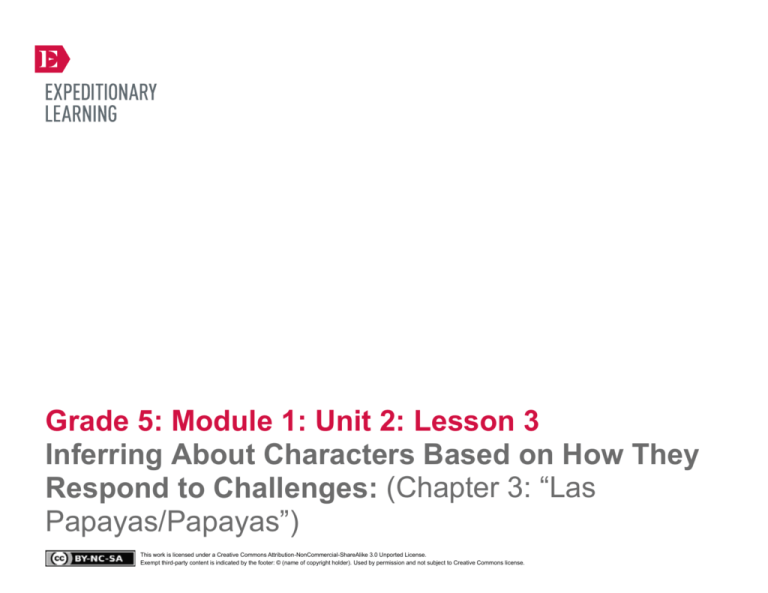
Grade 5: Module 1: Unit 2: Lesson 3
Inferring About Characters Based on How They
Respond to Challenges: (Chapter 3: “Las
Papayas/Papayas”)
This work is licensed under a Creative Commons Attribution-NonCommercial-ShareAlike 3.0 Unported License.
Exempt third-party content is indicated by the footer: © (name of copyright holder). Used by permission and not subject to Creative Commons license.
GRADE 5: MODULE 1: UNIT 2: LESSON 3
Inferring About Characters Based on How They Respond to Challenges:
(Chapter 3: “Las Papyayas/Papayas”)
Long-Term Targets Addressed (Based on NYSP12 ELA CCLS)
I can explain what a text says using quotes from the text. (RL.5.1)
I can make inferences using quotes from the text. (RL.5.1)
I can determine the meaning of literal and figurative language (metaphors and similes). (RL.5.4)
I can write informative/explanatory texts. (W.5.2)
Supporting Learning Targets
Ongoing Assessment
• I can answer comprehension questions based on text from Esperanza Rising that I have read
independently.
• Comprehension Quiz, Chapter 3: “Las Papayas/Papayas”
(entrance ticket)
• I can identify situations in Esperanza Rising where a character’s human rights are challenged.
• Triad discussions
• I can make inferences from the text about Esperanza, Mama, and Abuelita.
• Exit Ticket: Independent answer to text-dependent
question
• I can use context clues to help me determine the meaning of words in Esperanza Rising.
• I can write to explain my thinking about the characters in Esperanza Rising.
Copyright © 2013 by Expeditionary Learning, New York, NY. All Rights Reserved.
NYS Common Core ELA Curriculum • G5:M1:U2:L3 • April 2014 •
1
GRADE 5: MODULE 1: UNIT 2: LESSON 3
Inferring About Characters Based on How They Respond to Challenges:
(Chapter 3: “Las Papyayas/Papayas”)
Agenda
Teaching Notes
1. Opening
• In advance: Read Chapter 3 and review the text-dependent questions (see supporting materials). Two
copies of the questions are provided: a blank to display for students, and one with answers for teacher
reference.
A. Entrance Ticket: Comprehension Quiz, Chapter 3:
“Las Papayas/Papayas”
(5 minutes)
B. Engaging the Reader: Oral Chapter Review (5
minutes)
2. Work Time
A. Revisiting Papa’s Death: Close Reading of Pages 22–
23 (15 minutes)
B. Challenges to Human Rights in Chapters 2 and 3 (10
minutes)
C. How Characters Respond to Challenges: Answering
Questions in Triads (15 minutes)
3. Closing and Assessment
A. Independent Answer (5 minutes)
B. Debrief (5 minutes)
4. Homework
• This lesson draws directly on the knowledge students built during Unit 1 about human rights. Students
revisit this topic in future lessons, so the discussion in Part B of Work Time is intentionally brief. Be
sure to have the Unit 1 anchor charts on specific articles of the UDHR available where students can see
them, to jog their memory. Also be sure students have their UDHR note-catchers.
• This lesson introduces a new routine: an entrance ticket comprehension quiz, intended to check
whether students have done their reading.
• Note that for the text-dependent questions, students are told some of the page numbers where the
answers can be found. This scaffolding will gradually be removed as students progress through the
novel.
• As in Lesson 2, students work in groups to answer text-dependent questions. Continue guided practice
as needed, but be sure during Work Time C, all students have their own copy of these questions to
reference as they work in their triads. Students may not have time to answer all text-dependent
questions; remind them that it is most important for them to discuss each question thoroughly and cite
evidence. Students will revisit the character analysis (begun in Lesson 3) during Lesson 4 as well.
• Based on how groups functioned on the first day of reading the novel, you might modify groups at this
time.
• This lesson reintroduces a pattern of analysis that students were first exposed to in Unit 1, when they
analyzed the firsthand accounts of human rights violations. Throughout their study of Esperanza,
students will consider the challenges characters face (including but not limited to human rights
challenges), how the characters respond, and how a character’s response helps us understand that
character and the themes of the novel.
• Review Think-Pair-Share, Write-Pair-Share, and Cold-Call protocols (Appendix 1)
Copyright © 2013 by Expeditionary Learning, New York, NY. All Rights Reserved.
NYS Common Core ELA Curriculum • G5:M1:U2:L3 • April 2014 •
2
GRADE 5: MODULE 1: UNIT 2: LESSON 3
Inferring About Characters Based on How They Respond to Challenges:
(Chapter 3: “Las Papyayas/Papayas”)
Lesson Vocabulary
Materials
independently, identify,
comprehension, challenge, infer,
inference, quotes, inferential, denial of
property, human rights,
discriminatory, anguish, smothered
(23), composure, indignation
• Comprehension Quiz Entrance Ticket (Chapter 3: “Las Papayas/Papayas”) (one per student)
• Esperanza Rising (book; one per student)
• UDHR note catcher (from Unit 1; students’ completed copies)
• UDHR articles anchor charts (from Unit 1)—ideal, but not essential
• Evidence flags (sticky notes: the smallest size available or larger sizes cut into strips)—two baggies per student (one each for
home and school)
• Text-dependent questions for Chapter 3: “Las Papayas/Papayas” (one per student and one to display)
• Text-dependent questions for Chapter 3: “Las Papayas/Papayas” (Answers for Teacher Reference)
• Norms for Triad Talk anchor chart (from Lesson 2)
• Homework: Purpose for Reading, Chapter 4: “Los Higos/Figs” (one per student)
• Human Rights Challenges in Esperanza Rising anchor chart (new; teacher-created; see Work Time B)
• Inferring by Using Text Clues anchor chart (new; teacher-created; see Work Time A)
• Student journals
• Reading Esperanza Rising anchor chart
• Index cards or half-sheets of paper
Copyright © 2013 by Expeditionary Learning, New York, NY. All Rights Reserved.
NYS Common Core ELA Curriculum • G5:M1:U2:L3 • April 2014 •
3
GRADE 5: MODULE 1: UNIT 2: LESSON 3
Inferring About Characters Based on How They Respond to Challenges:
(Chapter 3: “Las Papyayas/Papayas”)
Opening
Meeting Students’ Needs
A. Entrance Ticket: Comprehension Quiz, Chapter 3: “Las Papayas/Papayas” (5 minutes)
• Consider posting nonlinguistic
symbols to assist ELLs in
comprehension and making
connections.
• Remind students to sit with their triads throughout their study of the novel.
• Introduce the new routine of the comprehension quiz entrance ticket by reviewing the first learning target. Clarify the
meaning of the words comprehension and independently. Explain that this quiz will be a daily practice as we move through
Esperanza Rising, designed to assess whether students read and understood the text assigned for homework.
• Distribute the quiz and give students five minutes to complete it. Collect students’ work to review and/or assess.
• Some students may be unfamiliar
with academic vocabulary words
(e.g., comprehension, situation,
challenged, identify, explain). Clarify
vocabulary with students as needed.
B. Engaging the Reader: Oral Chapter Review (5 minutes)
Note: Keep this review short. Students analyze the chapter in more detail throughout the lesson.
• Posting points of class discussions
assists ELLs in comprehension.
• Remind students that their homework reading is a “first draft” read; they are not expected to understand everything. But it
is important that they feel accountable for the reading, practice reading on their own, and try their best.
• After the quiz, lead the class in a brief whole class review session, cold calling students to elicit a summary of the chapter
that was read for homework. Start with an open-ended question, such as: “What was this chapter mostly about?” or “What
happened in this chapter?” Encourage students to cite evidence or point to specific passages. Note which students are able
to answer the questions, and the quality of the answers.
• Then ask the last question from the quiz again:
* “At the start of Chapter 3, what does Esperanza dream about?”
Be sure students understand that she dreams Papa is still alive. This will serve as the transition to the next section of the
lesson.
Copyright © 2013 by Expeditionary Learning, New York, NY. All Rights Reserved.
NYS Common Core ELA Curriculum • G5:M1:U2:L3 • April 2014 •
4
GRADE 5: MODULE 1: UNIT 2: LESSON 3
Inferring About Characters Based on How They Respond to Challenges:
(Chapter 3: “Las Papyayas/Papayas”)
Work Time
Meeting Students’ Needs
A. Revisiting Papa’s Death: Close Reading of Pages 22–23 (15 minutes)
• Increase interactions with vocabulary
in context. This increases the rate of
ELL vocabulary acquisition.
• Remind students of the text-dependent questions they discussed about Chapter 2: “Las Uvas/Grapes.” Point out that many
of them may not have had time to fully discuss the fifth question:
* “At the end of the chapter, why does Esperanza feel her heart drop and that she has sunk into a ‘dark hole of despair and
disbelief’?”
• Ask students to talk in their triads briefly to remind each other what happened at the end of Chapter 2.
• Probe with a series of text-dependent questions:
• ELL language acquisition is
facilitated by interacting with native
speakers of English who provide
models of language.
* “Did Esperanza really sink into a hole?”
* “What does the word despair mean? Why does Esperanza feel despair?”
• If students do not mention the word grief, offer this vocabulary term as a precise way to describe Esperanza’s experience:
deep, deep sadness.
• Direct students to Chapter 3, the final two sentences on page 23, and ask:
* “What are ‘the events of last night’?”
* “Based on context clues, what might the word wrenched mean?”
* “The author says: ‘Her smile faded, her chest tightened, and a heavy blanket of anguish smothered her smallest joy.’
What might anguish mean? Is she really wearing a blanket?”
• Point out to students that the author is using language in very interesting ways to help readers understand what Esperanza
is feeling. They will explore this in more depth in future lessons.
• Point out that the author never directly tells readers that Papa died. Ask:
* “How were you able to figure out what happened?”
• Begin the Inferring by Using Text Clues anchor chart with a drawing of a stick figure with a thought bubble that says: “The
text says … so I infer that …” On this chart, add several of students’ examples about how they inferred that Papa died.
• Ask students to add an evidence flag to the opening of Chapter 3: “Las Papayas,” with the phrase “Esperanza grieving.”
(This early modeling of how to summarize a chapter in a phrase will help students begin to keep track of the main events. In
future lessons, students will begin to write their own evidence flags to summarize the chapter.)
Copyright © 2013 by Expeditionary Learning, New York, NY. All Rights Reserved.
NYS Common Core ELA Curriculum • G5:M1:U2:L3 • April 2014 •
5
GRADE 5: MODULE 1: UNIT 2: LESSON 3
Inferring About Characters Based on How They Respond to Challenges:
(Chapter 3: “Las Papyayas/Papayas”)
Meeting Students’ Needs
Work Time (continued)
B. Challenges to Human Rights in Chapters 2 and 3 (15 minutes)
• Read aloud the learning target: “I can identify situations in Esperanza Rising where a character’s human rights are
challenged.” Review the meaning of the word challenged in this context (tested or violated), which students should recall
from their study of the UDHR during Unit 1.
• Ask students to talk in their triads about the human rights they remember from their study of the UDHR. Direct them to
their completed UDHR note-catcher and UDHR anchor charts (from Unit 1). Give students a few minutes to skim
these documents, with which they should be quite familiar. Invite a few triads to share out some of the human rights named
in the UDHR and the nicknames students gave those rights during Unit 1.
• Ask students to share where they placed their evidence flags as they read Chapter 3: “Las Papayas” (for homework):
* “What challenges did the characters in this chapter face?”
* “Where are there examples specifically of human rights challenges?”
• If necessary, scaffold the students’ learning by asking them if they can find some of the following examples:
* A challenge to the right to life, liberty, and personal security (the murder of Esperanza’s father, p. 24)
* The discriminatory treatment of Indians compared to people of Spanish descent (pp. 12, 15–18)
* The denial of property rights to women (p. 30)
• Start a Human Rights Challenges in Esperanza Rising anchor chart to use throughout the novel as students find
more examples.
Copyright © 2013 by Expeditionary Learning, New York, NY. All Rights Reserved.
NYS Common Core ELA Curriculum • G5:M1:U2:L3 • April 2014 •
6
GRADE 5: MODULE 1: UNIT 2: LESSON 3
Inferring About Characters Based on How They Respond to Challenges:
(Chapter 3: “Las Papyayas/Papayas”)
Work Time (continued)
Meeting Students’ Needs
C. How Characters Respond to Challenges: Answering Questions in Triads (15 minutes)
• Consider writing and displaying steps
for multistep directions. ELLs can
return to steps to make sure they are
on track.
• Review the anchor chart Norms for Triad Talk (from Lesson 2). Have students remain in triads, but gather students’
attention whole group. Read aloud the learning target: “I can make inferences from the text about the characters in
Esperanza Rising.” Remind them that earlier in this lesson, they began an anchor chart and talked about how they were
able to make an inference that Papa died even though the author didn’t say it directly.
• Point out to students that the way people respond to challenges tells us a lot about who they are. Ask students to talk in
their groups about an example. Model as needed with something from your own life.
• When ELLs are asked to produce
language, consider providing a
sentence frame, sentence starter, or
cloze sentence to provide the
structure required.
• Read out loud the learning target: “I can write to explain my thinking about the characters in Esperanza Rising.” Tell
students that throughout their study of Esperanza Rising, they will be thinking about the challenges Esperanza and other
characters face, how those characters respond, and what that tells us about those characters. Remind them that they did
something similar when they read the firsthand human rights accounts at the end of Unit 1.
• Consider allowing students to draw
their observations, ideas, or notes
when appropriate. This allows ELLs
to participate in a meaningful way.
• Tell students that they will learn more about inference and keep practicing drawing inferences based on clues from the text.
Remind students of their work yesterday, using evidence flags to track their thinking as they read.
• Ask students to begin four new pages in their reading journal (one per character), and on each page quickly jot a
response to the following question:
“What do you already know about this character?”
– Esperanza
– Mama
– Abuelita
– Miguel
• Tell students that in the next lesson, they will focus more on Miguel; today they will just focus on Esperanza’s family.
• Distribute and display the Text-dependent Questions for Chapter 3: “Las Papayas/Papayas.”
• In triads, students should read aloud one text-dependent question at a time, and clarify any terms. They should then think
on their own, then talk together to answer the question, marking their answers with evidence flags. They do not need to
write complete answers to the questions at this point.
• Students should then repeat this cycle for the next question.
Copyright © 2013 by Expeditionary Learning, New York, NY. All Rights Reserved.
NYS Common Core ELA Curriculum • G5:M1:U2:L3 • April 2014 •
7
GRADE 5: MODULE 1: UNIT 2: LESSON 3
Inferring About Characters Based on How They Respond to Challenges:
(Chapter 3: “Las Papyayas/Papayas”)
Meeting Students’ Needs
Work Time (continued)
• As students work, monitor this discussion. Emphasize that the author is not telling the reader what the characters are like,
she is showing the reader how the characters behave, so that the reader can infer what the character is like.
• While circulating, make sure all students are participating. Reinforce students who are following the Triad Talk norms well.
Closing and Assessment
Meeting Students’ Needs
A. Independent Answer (5 minutes)
• For students who struggle, consider
providing extra time for tasks and
answering questions in class
discussions. ELLs often need more
time to process and translate
information.
• Remind students of what they did today by asking students to reread out loud the learning targets. Have students give
suggestions to add to the anchor chart Reading Esperanza Rising anchor chart. Make sure to add: “using context clues to
figure out vocabulary” and “thinking about how characters respond to challenges” to the chart.
• Distribute index cards or half-sheets of paper. Ask students to select one question (i.e., about just one of the characters)
from their Triad Talk discussion for which they feel that they have a complete answer. Ask students to write the number of
the question and their answer, using specific details from the text.
B. Debrief (5 minutes)
• Ask students to write a definition of inferring in their reading journal. Then ask students to share their definition with their
triad. Cold call a few students to share an inference they made about Esperanza, Mama, or Abuelita during class today.
Copyright © 2013 by Expeditionary Learning, New York, NY. All Rights Reserved.
• Consider allowing students to draw
their observations, ideas, or notes
when appropriate. This allows ELLs
to participate in a meaningful way.
NYS Common Core ELA Curriculum • G5:M1:U2:L3 • April 2014 •
8
GRADE 5: MODULE 1: UNIT 2: LESSON 3
Inferring About Characters Based on How They Respond to Challenges:
(Chapter 3: “Las Papyayas/Papayas”)
Homework
Meeting Students’ Needs
• Read Chapter 4: “Los Higos/Figs” (pages 30–57) in Esperanza Rising. Use the Homework: Purpose for Reading,
Chapter 4: “Los Higos/Figs” question to focus your reading. Use evidence flags to mark the specific areas in the book
that support your answer.
• Audio recordings of text can aid
students in comprehension. Students
can pause and replay confusing
portions while they follow along with
the text.
Note: If concerned about students completing the reading assignment at home, plan an additional reading period later in
the day or first thing in the morning. All students should come to expect that they will use some of the “slushy time” during
the day—right before or after lunch, during downtime between other tasks, as they enter the classroom in the morning or
just before dismissal, as time for reading the novel or independent reading. In addition, students likely to need additional
support should preread this novel with support during intervention or other support periods. Prereading with support will
then allow students to spend class periods rereading and focusing on evidence.
Copyright © 2013 by Expeditionary Learning, New York, NY. All Rights Reserved.
NYS Common Core ELA Curriculum • G5:M1:U2:L3 • April 2014 •
9
Grade 5: Module 1: Unit 2: Lesson 3
Supporting Materials
This work is licensed under a Creative Commons Attribution-NonCommercial-ShareAlike 3.0 Unported License.
Exempt third-party content is indicated by the footer: © (name of copyright holder). Used by permission and not subject to Creative Commons license.
GRADE 5: MODULE 1: UNIT 2: LESSON 3
Comprehension Quiz Entrance Ticket
(Chapter 3: “Las Papayas/Papayas”)
Name:
Date:
1. At
the start of Chapter 3: “Las Papayas,” what does Esperanza dream about?
2. What does Tío Luis ask Mama to do?
3. What is Mama’s answer?
Copyright © 2013 by Expeditionary Learning, New York, NY. All Rights Reserved.
NYS Common Core ELA Curriculum • G5:M1:U2:L3 • April 2014 •
11
GRADE 5: MODULE 1: UNIT 2: LESSON 3
Comprehension Quiz Entrance Ticket
(Chapter 3: “Las Papayas/Papayas”)
4.
What is Miguel planning to do now?
5. What did Señor Rodriguez bring for Esperanza’s birthday?
Copyright © 2013 by Expeditionary Learning, New York, NY. All Rights Reserved.
NYS Common Core ELA Curriculum • G5:M1:U2:L3 • April 2014 •
12
GRADE 5: MODULE 1: UNIT 2: LESSON 3
Text-Dependent Questions for Chapter 3:
“Las Papayas/Papayas”
1. Esperanza: How is Esperanza responding to her father’s death?
Reread the following passages and discuss with your triad:
- Page 25, the paragraph that begins “She took a quivery breath …”
- Pages 27–28
What other evidence can you find in Chapter 3 that shows how Esperanza is responding?
2. Mama: How is Mama responding to her husband’s death?
Reread the following passages and discuss with your triad:
- Page 27, the paragraph that begins “Esperanza avoided opening her birthday gifts …”
- Pages 30–31
3. Abuelita: How does Abuelita respond to Esperanza’s uncles?
Reread the following passages and discuss with your triad:
- Page 32, near the bottom on the page. Why does Abuelita call the uncles “vultures”?
4. Vocabulary: On page 29, it says, “Mama did not answer but maintained her composure.”
Based on the context, and on what you know about Mama, what do you think the word “composure”
means? Explain your thinking.
5. Vocabulary: On page 30, it says, “A look of indignation passed between Mama and Abuelita.” Based
on the context, and on what you know about Abuelita, what do you think the word “indignation”
means? Explain your thinking.
Copyright © 2013 by Expeditionary Learning, New York, NY. All Rights Reserved.
NYS Common Core ELA Curriculum • G5:M1:U2:L3 • April 2014 •
13
GRADE 5: MODULE 1: UNIT 2: LESSON 3
Text-Dependent Questions for Chapter 3:
“Las Papayas/Papayas”
(Answers for Teacher Reference)
1.
Esperanza: How is Esperanza responding to her father’s death?
Reread the following passages and discuss with your triad:
- Page 25, the paragraph that begins “She took a quivery breath ...”
- Pages 27–28
What other evidence can you find in Chapter 3 that shows how Esperanza is responding?
Esperanza is very, very sad that her father died. She is missing him, particularly
because it is her birthday. She almost can’t believe this is happening to her. “She felt
like she was in someone else’s body, watching a sad scene but unable to help”(p. 25).
She cries almost every night—”Esperanza often woke to Mama’s soft crying. Or Mama
woke to hers”—and doesn’t even want to open her birthday gifts. “Esperanza avoided
opening her birthday gifts” (p. 27). She was so sad she couldn’t even speak.
“Esperanza couldn’t talk. Her heart felt so big and hurt so much that it crowded out
her voice” (p. 28).
2.
Mama: How is Mama responding to her husband’s death?
Reread the following passages and discuss with your triad:
- Page 27, the paragraph that begins “Esperanza avoided opening her birthday gifts …”
- Pages 30–31
Mama is trying to stay strong for Esperanza, encouraging her to go on with her life by
opening her birthday gifts. “Mama insisted, saying, ‘Papa would have wanted it’” (p.
27). Although Mama did not like what Tio was doing trying to buy their house, she
was strong and stood up to him. “So, no, I will not sell” (p. 31).
Copyright © 2013 by Expeditionary Learning, New York, NY. All Rights Reserved.
NYS Common Core ELA Curriculum • G5:M1:U2:L3 • April 2014 •
14
GRADE 5: MODULE 1: UNIT 2: LESSON 3
Text-Dependent Questions for Chapter 3:
“Las Papayas/Papayas”
(Answers for Teacher Reference)
3. Abuelita: How does Abuelita respond to Esperanza’s uncles?
Reread the following passages and discuss with your triad:
- Page 32, near the bottom on the page. Why does Abuelita call the uncles “vultures”?
Abuelita knows that the uncles are not doing the right thing. Right before she calls
them “vultures,” the uncle said, “You will regret the decision, Ramona. You must
keep in mind that this house and those grapes are my property. I can make things
difficult for you. Very difficult.” She thinks they are taking things that do not
belong to them (p. 32).
4. Vocabulary: On page 29, it says, “Mama did not answer but maintained her composure.”
Based on the context, and on what you know about Mama, what do you think the word
“composure” means? Explain your thinking.
“Composure” means that Mama stayed calm and did nothing, because the
paragraph that follows the sentence that has “composure” in it goes on to say,
“They nodded to Abuelita but, as usual, said nothing to Esperanza” (p. 29). It does
not say anything about Mama.
5. Vocabulary: On page 30, it says, “A look of indignation passed between Mama and Abuelita.”
Based on the context, and on what you know about Abuelita, what do you think the word
“indignation” means? Explain your thinking.
“Indignation” means angry, because in the sentence right before the one with
“indignation,” Esperanza “wipes away angry tears” (p. 30). The next sentence,
referring to Mama and Abuelita, says, “Were they feeling the same way?”
Copyright © 2013 by Expeditionary Learning, New York, NY. All Rights Reserved.
NYS Common Core ELA Curriculum • G5:M1:U2:L3 • April 2014 •
15
GRADE 5: MODULE 1: UNIT 2: LESSON 3
Homework:
Purpose for Reading, Chapter 4:
“Los Higos/Figs” (Pages 39–57)
Name:
Date:
What challenges do the characters in this chapter face? How does each character respond?
As you read, think about these questions. Use your evidence flags to mark specific passages in
the text to discuss with your triad. You do not need to write out answers as part of your
homework; just keep track of your thinking with your evidence flags.
Copyright © 2013 by Expeditionary Learning, New York, NY. All Rights Reserved.
NYS Common Core ELA Curriculum • G5:M1:U2:L3 • April 2014 •
16

